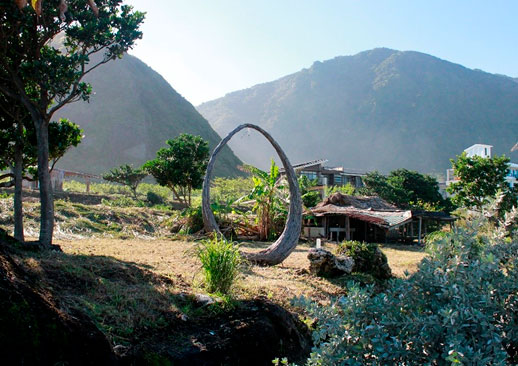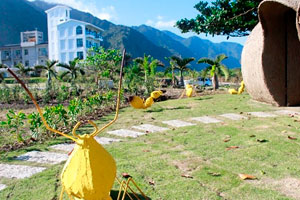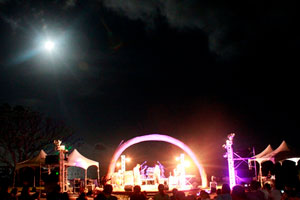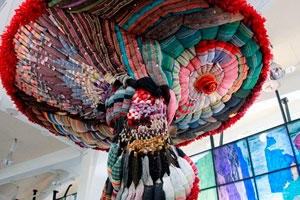Land Art and creativity in Taiwan
Jose David Quiñones V

“The Poetry of Nature express itself through Land Art in a symbiotic process that connects the people with the landscape; The trees, the rocks, the sea, the Mountains and the sky get to speak and whisper the story of creation while women keep the secret of weaving in the Universe”[1]
From the many ways of expression that you can see in Taiwan, between temples and high buildings, museums and all kind of theatres, the landscape is something unique and impressive. For this reason, the island was properly called by the Portuguese Isla Formosa. Surrounded by mountains and bathed by astonishing rivers and lakes, the island would be easily associated with paradise or a magnificent artwork of the creator. Taiwan is a great source of inspiration for the artists and a place to enjoy for the inhabitants and visitors who get to know the charm of such a beautiful land.
The nature here expresses itself in a very wild and exotic way. The melody of the waves of the sea, plays with the wind that arises from the south announcing the Typhoon, while the trees get a shower from the rain, and the land makes flourish the plums, the cherries and the orchids. While the blue magpie sings, the silence of the mountains reveals the light of the sun and the rainbow of the ancestors appear in the sky.
Within this atmosphere all set up, the land art expressions of the natives, take place in a wonderful festival along the east coast of the island. People from all around the world celebrate in peace and harmony the encounter of different cultures, different ideas and varied ways of creativity that expose their talent in complete understanding with the earth.
The Tecland Art Festival, started in 2015 with the collaboration of the Administration of Taiwan Tourism Office (ECNSAA) as an open exhibition of the local artworks and workshops of the artists of different regions with a permanent residence in the East Coast National Scenic Area. During 2016, this initiative involved the participation of new artists who opened studios, art markets, and a varied agenda of performances and concerts along the Hualien- Taitung Coast Highway.
The event was focused on the concept of “Land aArt” and privileged the local indigenous creations as combination of their lifestyles with the natural environment. The main goal of this event, was to show the exuberant landscape of the region in a more artistic way in which the visitors could recreate themselves as participants of the artworks. Furthermore, they wanted to create a cultural platform where the values of the region where highlighted to attract the attention of the experts and the international community. In this sense, the festival wanted to connect the 5 continents to expand the art network of Taiwan and its influential area.
Participants
The main participants of the residence project, were 6 Taiwanese artists and 2 international artists between other local participants that showcased their artworks in different places of the region as part of the landscapes, or as an attraction in some other cases.
Topic and Materials
The organizers of the Tecland festival, emphasise in some of the topics and materials that where exhibited in this event. As an example, we can mention the one called “Poetic Living: A rest stop in landscape” in which people were able to participate by going inside and have the experience of a calm and relaxed environment while the kids where playing aside. In this scene, there was also the possibility to make a sculpture with raw materials, build a tearoom with bamboo or evoke a poetic road with stones.
It is important to highlight that all the artworks of this exhibition were supposed to last one year so they were made with strong and safe bases to guarantee its permanence in the minimum required conditions as stablished by the sponsors. (The East Coast National Scenic Area Administration (ECNSAA) of Taiwan Tourism Bureau, and Wata Creative Integration Company).
Organizers
The organizers of this event, where encharged to promote the festival while recruiting the people and defining the spaces, where to display all the art works. The Director was Nakau Putum, the second director was Su Ssu Ming, the artistic director was Pan Sheau-Shei [Yuki], The curator was Lee Yun-Yi the responsible for the Administrative part was Wu Shu-Lun, for artistic and recreational activitie was Huang Fu-Kuai, for the Promotions of the event were Huang, Jin-Chen and Yang Cheng-Tuz and for the Film Making Cameron Hanson andTommaso Muzzi.

The experience of the participants
By interviewing some of the visitors of the festival, and in my own personal experience, the Land Art festival of the East coast of Taiwan was a complete journey to the most agreeable and astonishing places of the east coast and a delight of different flavours of its gastronomic offer at the same time that we were appreciating the different artworks of the artist.
Although, I must say that since time was taking advantage and the artists where not there all the time to present their art works, much of the interesting discussion of some exhibitions where missing as the information of how they made them and which was their inspiring motive.
Nevertheless, most of the participants agreed to conclude that the event was a very creative idea and that the experience of traveling around the east coast was very meaningful and rich in terms of the landscape and its relation with the artworks and crafts. Overall there where some artworks that called our attention and in this report we will discuss one of the most interesting ones.
The closing concert was in my personal opinion, one of the most harmonious scenarios given the combination of the landscape, the people, the music, and the scenery itself. It was a real Land Art exhibition and an interactive space that had a lot to offer to the participants and the usual visitors.

Taoyuan Land Art Festival
At the same time, the Taoyuan Landscape Art Festival was taking place in the west side of Taiwan with the participation of around nine hundredth thousandths people from the 9th to the 25th of September, so there were lots of people traveling all around the Island with a huge and varied cultural offer that was open to all kinds of public.
Land Art
The concept of Land Art, was part of an art movement of contemporary art that started to transform different scenarios by the use of natural elements and raw materials. It is based on the use, transformation or modification of wood, soil, sand, wind, fire and water, as means of artistic transformation and agents of symbolic and solid meaning.
The expression comes from the British Contemporary Art Movement that started to develop the use of it as a way of building the landscape. Land Art, or Earth Art is usually associated with a controversial position of the art meaning and aims to protect the environment or at least give a deeper meaning to it in which nature and art are in a deep connection and as a result the environment is transformed in a piece of art.
Usually the artworks are exposed in the outside so that the natural elements can also shape them, or play with them, or simply live together as a whole piece of nature in its own balance. For this reason, some Land Art works have disappeared and the footprints are just taken by pictures.
The beginning of this type of art, its whole concept and ideas, was born in the wild wild west of the United States at the end of the 60’s, and the first works where actually called earthworks because the use of heavy machines was applied to remove the soil, or to give a different shape to a vast terrain.
Nowadays this mixture between architecture and sculpture generated in a particular space recreating a new atmosphere, is also being used in the contemporary public space of the cities. From the large desserts and mountain, to the sea and the forest, the Land Art is somehow transforming into the art of the public space.
As a new movement, it is far away from the traditional ideas of the 60’s and 70’s where the commercialization of art was getting a market through paintings and sculptures in the gallery, and its exposing art for everyone in the everyday life common places of the city. As an example, we should mention the magnificent work of Labay Eyong from the Seediq aboriginal tribe who’s inspiration in traditional weaving traces a new route for the coming generation of artists in Taiwan. Her art work was exhibited at the Taroko railway station at the same time of the Land Art Festival.
Labay Eyong:
According to Kelly Her from Taiwan Today, “In recent years, aboriginal artists have been playing an increasingly significant role in efforts to preserve the diverse cultures of Taiwan’s indigenous peoples. By recording tribal histories, promoting native languages and highlighting traditional practices, talented individuals such as Seediq installation artist Labay Eyong are inspiring younger generations to explore their aboriginal heritages”[2]
It is known that in this present era of globalization, the indigenous communities have a tremendous challenge to preserve their culture, their language and traditions. Although, the challenge also comes with opportunities as the values and identity of a tribe can be expressed through art as a universal way of expression. In this sense, the artwork of Labay Eyong is remarkably original, fully creative, spontaneous and unique, as an example of her tribe tradition and way of thinking.
Labay Eyoung, was born in the rural town of Wanrong in Hualien County in 1982. Her father was a Seediq and her mother a Han Chinese. She studied arts in the Fu Jen Catholic University of New Taipei City and graduated in 2004. To complete her studies, she went to Barcelona and got a master degree from the school of design at the Autonomous University of Barcelona in 2008.
When she came back to Taipei, she found out that everything had changed in a very modern way. In her own words, “The old way of life had largely disappeared, and mainstream forms of recreation, such as karaoke and mahjong, had become popular among tribespeople,” she recalls. “I felt a great sense of loss, and the only comfort I got was from seeing a few elderly women weaving.”[3]
Many things came up to her mind, and she felt like if one of the most important traditions of her tribe was getting lost, so she went to visit some old women who were still weaving and started learning. With the coming time, she also wanted to make a register of the women weaving so she called Chen Ro-Hsuan (陳若軒) to take some pictures and later they wrote a book with all the collected material.
The book called Tminun Pdsun was published in 2011, and it “shows images and text to highlight the prominent role that weaving plays in Seediq culture. Tminun and pdsun mean “weaving” and “giving” respectively in the Sediq language.[4]” Furthermore it is important to highlight that “In the past, Seediq girls had to learn how to weave before they could get a facial tattoo [a symbol of adulthood],” she explains. “They were only considered women once they knew how to weave.”[5]
Labay is an example of the great aboriginal artists who has dedicated her life to protect and promote the culture of her tribe. For the Seediq, the crafts are very significant and represent an entire tradition, a way of thinking and a way of being and leaving. In her work I am a woman, she emphasises in the fact of becoming a woman by learning how to weave so she decided to open a studio where many other girls and women can continue with their traditional practices while exhibiting their own cultural identity.
After winning the top prize at the Pulima Arts award, (“Pulima means “an accomplished artisan” in the Paiwan language), her work has been admired by the gigantic uterus that was weaved for hours using different colours and showing the splendid world of the women’s body and its deep meaning in relation with creation and the important role of the women for our entire lives as humans.
This uterus is an example of the new art movements and it was exhibited at the Toroko Railway station creating a magnificent environment and recreating the importance of the native culture and art works in the region while showing how creativity can be a source of inspiration for the people all around the world.

Today, she is working with around 30 weavers from the Atyal, the Seediq and Truku tribes to continue with her aims of creating, protecting and promoting the traditional indigenous art and tradition.
Conclusions
In conclusion, the Land Art Festival realised in Taiwan during 2016, was a perfect scenery to exhibit many of the artworks of the indigenous people at the same time that their culture, values and identity were promoted.
The relation between nature and art make a powerful combination of the source of creativity, inspiration and knowledge that is shared among the different tribes in Taiwan, Asia, and the international community.
The Art work of Labay Eyong was specially recognized given its deep meaning, the beauty that resides inside of it and the important connection that reveals between tradition and creativity. It is a true source of inspiration from the most exquisite nature of human life and a real way to promote the values of a culture in which being a woman means learning to weave their thoughts in the universe.
Bibliography
https://taiwaneverything.cc/2016/09/08/taoyuan-land-art-festival-sept-925/
http://taoyuanlandart.com.tw/tw/news_detail.php?no=20160929001
http://2016.teclandart.tw/english/
http://taiwanreview.nat.gov.tw/search.php?key=Labay%20Eyong
https://en.wikipedia.org/wiki/Land_art
Quinklan photography. All rights reserved.
[1] The Author.
[2] See: Her Kelly, Reconstructing Tribal Identity, Taiwan Today, 2015
[3] Ibid
[4] Ibid
[5] Ibid